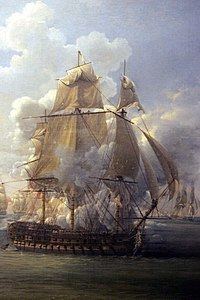Name Hercule Ordered 14 August 1793 Laid down June 1794 Construction started June 1794 Length 56 m Beam 15 m | Completed March 1798 Launched 5 December 1797 Weight 2,966 tons | |
 | ||
HMS Hercule was a 74-gun third rate ship of the line of the Royal Navy. She was previously Hercule, a Téméraire class ship of the line of the French Navy, but was captured on her maiden voyage in 1798, and spent the rest of her career as a British ship. She was broken up in 1810.
Contents
French career and capture
During her maiden journey, on 21 April 1798, and just 24 hours out of port, she was captured by the British ship HMS Mars after a violent fight at the Battle of the Raz de Sein, off Île de Sein near Brest. Hercule attempted to escape through the Passage du Raz, but the tide was running in the wrong direction, and she was forced to anchor, giving the British the chance to attack at close quarters. The two ships were of equal force, both seventy-fours, but Hercule was newly commissioned; after more than an hour and a half of bloody fighting at close quarters she struck her colours at 10.30 pm, having lost — by her own officers' estimate — 290 men killed and wounded. On Mars 31 men were killed, including her captain, Alexander Hood, and 60 wounded. Captain Louis Lhéritier of Hercule was wounded by sabre and spike leading his boarding party.
The Hercule was recommissioned in the Royal Navy as HMS Hercule.
British career
In mid-1803, the squadron under Captain Henry William Bayntun, consisting of Cumberland, Hercule, Bellerophon, Elephant, and Vanguard captured Poisson Volant and Superieure. The Royal Navy took both into service.
In May 1803, MHS Hercule's captain Solomon Ferris died suddenly on board the ship.
On 28 June 1803, during the Blockade of Saint-Domingue, HMS Hercule encountered the French frigate Poursuivante and the corvette Mignonne. Hercule attempted to capture the Poursuivante, but the frigate outmaneuvered her and she received raking fire. The Hercule was under the command of first lieutenant John B Hills at the time, who was assigned acting captain because Captain Ferris had died the previous month. The incident was immortalised in a painting by Louis-Philippe Crépin. HMS Goliath then captured Mignonne.
Officers in 1803
In the book, 'The Naval History of Great Britain' by William James lists most of the officers on board.
The commissioning captain, Captain Solomon Ferris proved a strong judge of character. His personally chosen lieutenants achieved success in the navy with two of them being knighted.
Perrot was mentioned in dispatches after losing an arm to a Dutch cannonball shot moments after swapping seats with lt. Willoughby during the siege of Curacoa.
